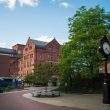Civic League announces award winners
The Denver-based National Civic League has named the winners of its All-America City awards, tapping communities as small as Clinton, Mo. (population 9,248) and as large as Montgomery County, Md. (population 850,000). Founded in 1949, the award is the oldest community recognition program in the nation, lauding communities whose residents work together to identify and tackle community-wide challenges. Since the program’s inception, more than 4,000 communities have competed, and nearly 400 have been named All-America Cities.
The 2000 winners are:
Fresno, Calif. (population 415,381)
The Hope Now for Youth program was founded in 1993 to give gang members an alternative to a life of crime. It has helped 560 youths, ages 16-24, leave the streets. Hope Now’s staff members work from their homes or in space donated by six churches. Community support is provided by 180 employees, judges, physicians, attorneys, accountants and volunteers. Each youth is offered free work-ethic training, vocational placement, psychological counseling, legal assistance, tattoo removal, and medical and dental care. Sports and social events are offered to break down inter-gang barriers.
The program has been statistically effective, employing 510 youths in Fresno since its inception. Of the young men who turn to Hope Now, 85 percent are successfully placed in full-time jobs, and 91 percent of them do not relapse into crime. Since 1994, juvenile arrests for murder have dropped from 15 to 0, and arrests for auto theft are down from 678 to 107.
The Oso de Oro park was built by the city in 1995 to benefit physically challenged children. Oso de Oro, meaning “Bear of God,” has become an important part of the lives of the blind and physically challenged children who use it. The park was constructed with meticulous attention to the unique physical, emotional and educational needs of the children. It showcases the natural and cultural history of California and includes a frontier fort, Spanish ruins, a maze for the sight-impaired that features historic relief tiles, a mining town, swings adapted to four levels of ability, and separate playgrounds for different age groups. Since 1995, more than 315,000 people have visited the 10-acre park.
Care Fresno was established in 1995 to turn around high-crime neighborhoods. The team is composed of one full-time police officer, two civilian staff members, 31 churches, 500 volunteers and owners of apartment complexes in high-crime areas, who donate vacant units for use as Neighborhood Resource Centers. Since 1995, 31 neighborhood centers have been established, serving a total of 4,485 residents. Children tutored at the centers are showing improvements in grades and school attendance, while calls for police serv-ice have dropped by 60 percent.
Lower Naugatuck Valley, Conn. (population 126,052)
The Boys and Girls Clubs opened a 30,000-square-foot, $4.5 million facility on what had been the area’s most blighted property. To build the facility, the clubs purchased contaminated factories, demolished them and cleaned the two-acre parcel on which they were located. The center serves more than 1,400 members. Homework and computer rooms can accommodate 50 children per hour, and the facility includes a 10,000-square-foot gym and state-of-the-art weight-lifting facility.
Project Co-N-E-C-T, which stands for “Community’s Need for Evaluation, Care and Treatment,” is a valley- wide effort to assess the health needs of 5,000 medically under-served residents. The goal of the project is to improve the health of residents by identifying and lowering the risk of preventable illness through improving access to needed services, health education, prevention and wellness programs. The project helps identify residents without family doctors or primary care sources and people with medical risks and connect them to health services.
The Alliance for Economic Growth is a non-profit 501C corporation involving seven towns that work collaboratively on economic development issues. The corporation works with business and municipal leaders to plan, recommend and implement regional economic development activities designed to bring new jobs and opportunities to the region. The Alliance has been involved with creation of a regional brownfield project to restore toxic properties to productive use; a transportation task force to increase public transportation; a marketing campaign to recruit new companies to locate to the community; and a lead management program to distribute economic development leads fairly to towns.
Worcestor, Mass. (population 167,383)
YouthNet is a citywide network of free programs designed and implemented by young adults to provide summer recreational, educational and cultural activities to isolated and under-served middle school youth. Staff members encourage participants to develop leadership, responsibility and interpersonal skills. YouthNet offers activities including computer training, team sports, karate, rock climbing, crafts, community service, education seminars, field trips, talent contests and more. More than 7,000 young people have participated in the program since 1992.
The BeaconBrightly Advisory Committee was created in 1994 to renovate and rehabilitate the BeaconBrightly neighborhood. The committee achieves its goals by forming partnerships with city leaders; police, fire, health/code and youth services; religious, educational and business organizations; Clark University; local banks and the Community Development Corp. Since 1995, the committee has helped renovate 31 abandoned buildings, plant 200 trees, reclaim a neglected park and remove 137 tons of trash from streets and lots.
The Worcester Evening Free Medical Service Program provides free health care to medically under-insured or uninsured people. The WEFMSP offers free health care two hours a week in the basement of Epworth United Methodist Church. More than 200 doctors, nurses, medical students, chiropractors, massage therapists, social workers, and community and church members have volunteered in the program, which was started in 1994. Eye and ear care programs now are offered at another site. The program has logged 14,000 patient visits and has saved hospitals and the community approximately $1 million over six years.
Montgomery County, Md. (population 850,500)
Brothers Reaching Out To Help Each Reach Success (BROTHERS) is a mentoring and education program for minority and at-risk males. College students mentor high school youths, who, in turn, mentor middle school and elementary children. Meetings occur twice a week after school. All of the high school seniors participating in the program last year graduated from high school, and 98 percent went on to college. This year, more than half of the participants have increased their grade point averages and school attendance, and the program has resulted in lower drop-out rates, improved conflict resolution skills and improved social awareness.
Linkages to Learning is based on partnerships between public and private agencies, schools, families and communities. It is active in 14 county schools and provides direct services and referrals to children and families.
The program is aimed at breaking down non-academic barriers to learning such as linguistic and cultural differences; lack of transportation and childcare; and access to pediatric and mental health care. One of the program’s newest efforts is “Linkages to the Library,” a project designed to promote family literacy, improve students’ reading skills and encourage parental involvement in their children’s academic performance.
Clinton, Mo. (population 9,248)
Students Together Achieving Responsible Tasks (START) is a youth community service organization of 200 students serving the Chamber of Commerce, local businesses, churches, civic and charity organizations, and schools as ambassadors to the younger population. START’s volunteer force provides manpower to help those organizations sponsor events that might otherwise have been too overwhelming. In return for volunteering, students earn community service hours for A+, a program that pays tuition at two-year colleges. Between 1998-1999, START volunteers accumulated 6,208 volunteer hours.
Cardiovascular disease is one of the leading causes of death in Clinton, Mo. Joint efforts coordinated by public, non-profit and private organizations are addressing cardiovascular risk factors, enhancing lifestyles and improving overall community wellness. CHART, the Community Health Assistance Resource Team, has helped create awareness by performing blood pressure and cholesterol screenings at school sporting events and at the city’s Wellness Fair. In February 1999, the Clinton Community Center, which features an indoor walking track, cardiovascular and strength training equipment, an aerobics area, a children’s room, basketball courts and the Golden Valley Memorial Hospital Wellness Center, opened. The center has initiated a cardiac rehabilitation program, which provides supervised exercise for people with heart disease.
Gastonia, N.C. (population 62,077)
The West Gastonia Boys and Girls Club is confronting the problems facing 800 of the city’s most disadvantaged children. The Study Buddy Program allows volunteers to provide one-on-one help and encouragement to more than 100 children daily. Several programs help children acquire proper reading and writing skills, and a hunger prevention program feeds an average of 100 children nightly.
Unity Place – A Parable of Art ‘n Heaven allows the United Arts Council and St. Stephens Church to promote art and religion as compatible sources of inspiration and motivation, and it provides guidance and support to the community through involvement in programs reflecting community and family values. Unity Place serves as the center of worship for 350-member St. Stephens’ congregation, and it is home to the Gaston Dance Theater, the Gaston School of the Arts, the Concert Association, the Choral Society, the Art Guild, the String Ensemble and the Gaston Chordweavers.
Make Room for Reading is a joint effort of the Gaston Literacy Council and the city’s First United Methodist Church. As a result of the collaboration, an old abandoned store was renovated to create a community literacy center. Eighty-one percent of the students receiving tutoring for one or more years have demonstrated progress in their schoolwork.
Fargo, N.D. / Moorhead, Minn. (population 81,715)
America’s Promise is part of a national effort to provide young people with five basic tools: an ongoing relationship with a caring adult; safe places and structured activities during non-school hours; a marketable skill through effective education; and an opportunity to participate in community service. Fargo Mayor Bruce Furness adopted a second grade classroom and has granted all city employees one paid hour per week to serve as mentors and coaches. The Moorhead Police Department is promoting 20 new block clubs to provide safe places for children. The Moorhead Community Education program has created a family literacy program and a kindergarten readiness brochure, and it has tripled the size of its tutoring program.
Formed in 1998, Project Tomorrow is a metropolitan area planning process involving 200 stakeholders who were chosen specifically to assure balance by race, gender, income level, longevity in the community and place of residence. Already, the stakeholders have proposed 49 separate beautification projects. A privately funded biotechnology/research park is being built to offer new opportunities to entrepreneurs and students.
The Cultural Diversity Project is a regional initiative to build inclusive communities that value diversity. It involves four cities and two counties in two states: Fargo, West Fargo and Cass County in North Dakota, and Dilworth, Moorhead and Clay County in Minnesota. Every year about 500 people in nearby businesses and institutions receive awareness training from the project. Additionally, bilingual interpreters serve about 5,000 people with limited English proficiency, and 40 ethnic leaders are trained to participate in public issues and policy-making. In 1999, 2,988 people of diverse cultural heritage received assistance in finding housing and/or employment.
Lancaster, Pa. (population 55,551)
The Lancaster Partnership is a collaboration of four minority-headed organizations working to address three initiatives: community and school, employment and training, and housing and economic development. The partnership has provided a safe haven program that serves 2,000 youths per day. It also has established a charter school for 85 middle school students, as well as a high school dropout reentry program that has returned 76.5 percent of its participants to school.
The SACA Development Homeownership Program is converting an area characterized by deteriorating rental properties and crime to solid homeowner neighborhoods. It has made it possible for lower-income families to become homeowners; 60 first-time buyers have purchased homes over the past six years. Approximately $2.6 million in mortgages have been generated, and neighborhood crime has dropped dramatically.
The Lancaster Campaign is a non-profit, apolitical organization in which city and county government, local development organizations, social serv-ice agencies and businesses are cooperating to implement a 10-point community vision statement. An important aspect of the initiative has been the formation of the campaign’s executive committee, which gathers city planning advice and perspectives from community institutions on a monthly basis. More than 250 volunteers work on the campaign. In 1998, the organization presented its Economic Development Action Agenda, which targeted specific areas for improvement and revitalization. Already, a $40 million private sector investment has been made in the target area, and a $2 million city government deficit has been eliminated.
Anderson County, S.C. (population 160,791)
Hanna-Westside Extension Campus houses virtually all high school technology and career programs for Anderson School District 5. Formerly McDuffie High School, the facility was known for low test scores and a high dropout rate. In 1996, a community committee recommended converting the high school into a technology extension campus. The facility now serves nearly 2,500 district high school students. The students may take classes in accounting, computer science, marketing, desktop publishing, computer-assisted drafting, culinary arts and other fields. Now, 95 percent of the students’ grades have improved, attendance has risen 3 percent, and dropout rates have declined. In 1998, the school was recognized as Palmetto’s finest high school, and, in 1999, it was named one of four national “blue ribbon” schools in South Carolina.
Founded in 1996, the Alliance for a Healthy Future is a joint effort of six local non-profit organizations. It helped finance construction of the state’s first residential home for the terminally ill, as well as a $13 million YMCA complex, and it provided funding for the conversion of an abandoned elementary school into a health clinic, branch library, police substation and child care center.
Built by the county in 1998-1999, the Anderson Sports and Entertainment Center includes an 18,000-seat amphitheater, athletic fields, walking trails and a picnic area. The $4.5 million facility was paid for by grants, a state tourism tax, contributions and bonds. Because of the center, Freedom Weekend, one of the country’s largest hot air balloon festivals, moved to Anderson and now brings the city $10 million a year. Softball tournaments held at the center generate $1 million annually. Additionally, there has been a 534 percent increase in retail development within a one-mile radius of the center.
Edinburg, Texas (population 48,505)
The South Texas Youth Initiative, a non-profit organization founded by high school students, was developed to teach elementary and secondary students effective leadership skills through workshops and service proj-ects. Funded with a $15,000 grant by the Kellogg Foundation, the program allows students to work alongside community leaders to develop an age-appropriate leadership curriculum. During the summer, participating students developed a workbook of age-specific presentations on topics such as self-esteem, drug awareness, conflict resolution and personal safety. The program has encouraged young people to develop strong ties with community and business leaders by participating in community projects.
Haggar, a worldwide manufacturing company, publicly announced that it was going to close its Edinburg plant. Research estimated that the city would lose 3,300 jobs and $25.8 million in revenue should the plant close. Consequently, the community formed a task force of citizens and local businesses, representatives from local governments, the Edinburg Chamber of Commerce and the Edinburg Regional Medical Center. The goal was to create a multi-purpose plan that would retain the Haggar facility. On March 7, 1997, Haggar announced that it would stay in Edinburg.
The Beautification Matching Loan Program, a joint effort of independent business owners, the Design of the City Committee, and the Edinburg Economic Development Council, was created to provide financing for repairs, renovations and improvements. Since the program’s inception, 30 businesses and nine city blocks have been improved with brick pavers, decorative lighting and landscaping.
For information about the All-America City Awards, contact the National Civic League, 1445 Market St., Suite 300, Denver CO 80202-1717; telephone (303) 571-4343.




















